Stage 1/2020 - Development of cellulosic materials containing CeO2 nanoparticles with catalytic activity under the action of UV light
Activity 1.1 - Preparation of hybrid composite materials by immobilization of CeO2 NPs (commercial, synthesized in our laboratory or organically modified) in native cellulose (avicel, fibers, cotton foil, cellulose acetate) or oxidized cellulose.
Activity 1.2 - Investigation of the catalytic performance of the prepared hybrid materials under UV irradiation
CeO2 nanoparticles were synthesized by two different methods. The prepared nanoparticles (NPs) and some commercial ones were functionalized on the surface with organic groups to be immobilized in a cellulose template, in order to obtain an improved dispersion of them and a better connectivity between NPs and the polymer matrix. Simple or organically modified CeO2 NPs were characterized by appropriate techniques (UV-vis, fluorescence, FTIR, ATG, X-rays, TEM). CeO2 NPs were immobilized in cellulose acetate, resulting in semi-transparent films. The photocatalytic activity of the films was investigated following the photodegradation of methyl-orange dye.

Schematic representation of the reaction pathways used for the preparation of CeO2 nanoparticles in the presence of (a) NaOH (pH = 5-6) or (b) NH4OH (pH = 8-9) and their corresponding TEM images.
Stage 2/2021 - Preparation, characterization and evaluation of photocatalytic efficiency of some hybrid materials containing CeO2 NPs immobilized in oxidized cellulose matrices or cellulose-based mixtures
Activity 2.1 - Preparation of hybrid composite materials by immobilizing CeO2 NPs (commercial, synthesized in our laboratory or organically modified) within native cellulose (avicel, fibers, cotton linters, cellulose acetate) or oxidized cellulose.
Activity 2.2 - Synthesis of hybrid composite materials by immobilization of CeO2 nanoparticles (synthesized in our laboratory or organically modified) within cellulose-based mixtures.
Activity 2.3 - Testing the catalytic performance of hybrid materials containing oxidized cellulose / cellulose-based mixtures - CeO2 NPs under UV irradiation.
In this stage, we continued the activities started in the previous step by preparing hybrid composites based on cellulose acetate and CeO2 nanoparticles with various concentrations (C2-F). The resulting films were thoroughly characterized (FTIR, SEM, EDX), and the photocatalytic performance was investigated by following the degradation of different contaminants (Congo red, methyl-orange, 4-nitrophenol). It has been observed that by modifying the cellulosic substrate after regeneration and oxidation reactions, active photocatalysts were succesfully used on the photoreduction of 4-nitrophenol to 4-aminophenol. The photocatalytic activity under UV irradiation was very good, while the results obtained under visible irradiation were very encouraging, too. In this stage, six types of CeO2 NPs were synthesized and characterized by FTIR, XRD, SEM and TEM techiques. Their optical properties (UV-Vis spectroscopy) evidenced that two of the samples have lower values of the forbidden band energy (Eg), and are expected to have photocatalytic activity in the visible range. For this reason, they were immobilized in various gravimetric proportions of oxidized cellulose / polyvinyl alcohol blends, and were preliminarily characterized by FTIR and SEM images.
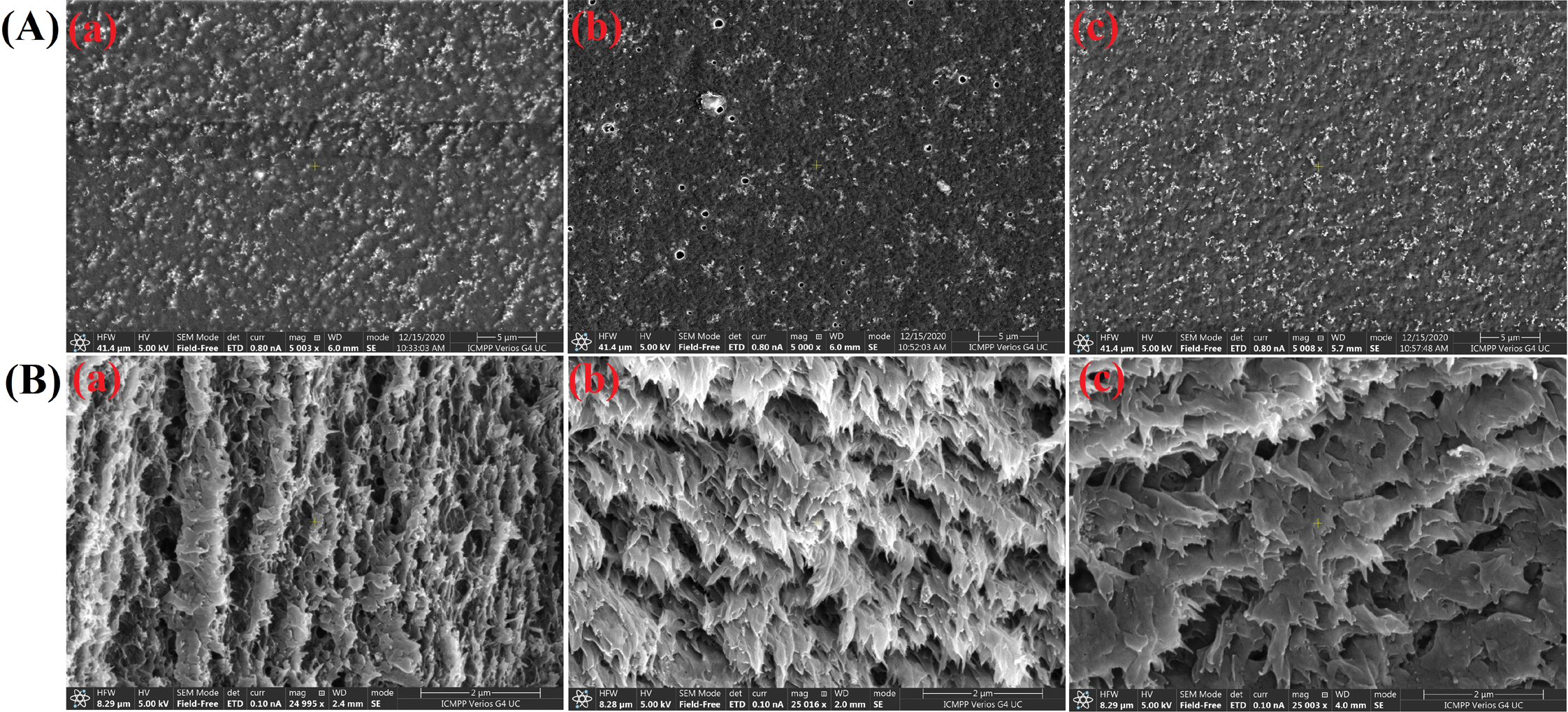
SEM micrographs of hybrid films recorded (A) on the surface and (B) in cross section: (a) CelA_C2-F-5% , (b) Celreg_C2 F-5% and (c) Celox_C2-F-5%

Various types of 4 – NPh transformation reactions in the presence of catalyst films containing 5 wt% CeO2 NPs (C2-F) and various cellulosic substrates on the surface: cellulose acetate (CelA_C2 – F-5%), regenerated cellulose (Celreg_C2 – F -5%) or oxidized cellulose (Celox_C2 – F-5%)
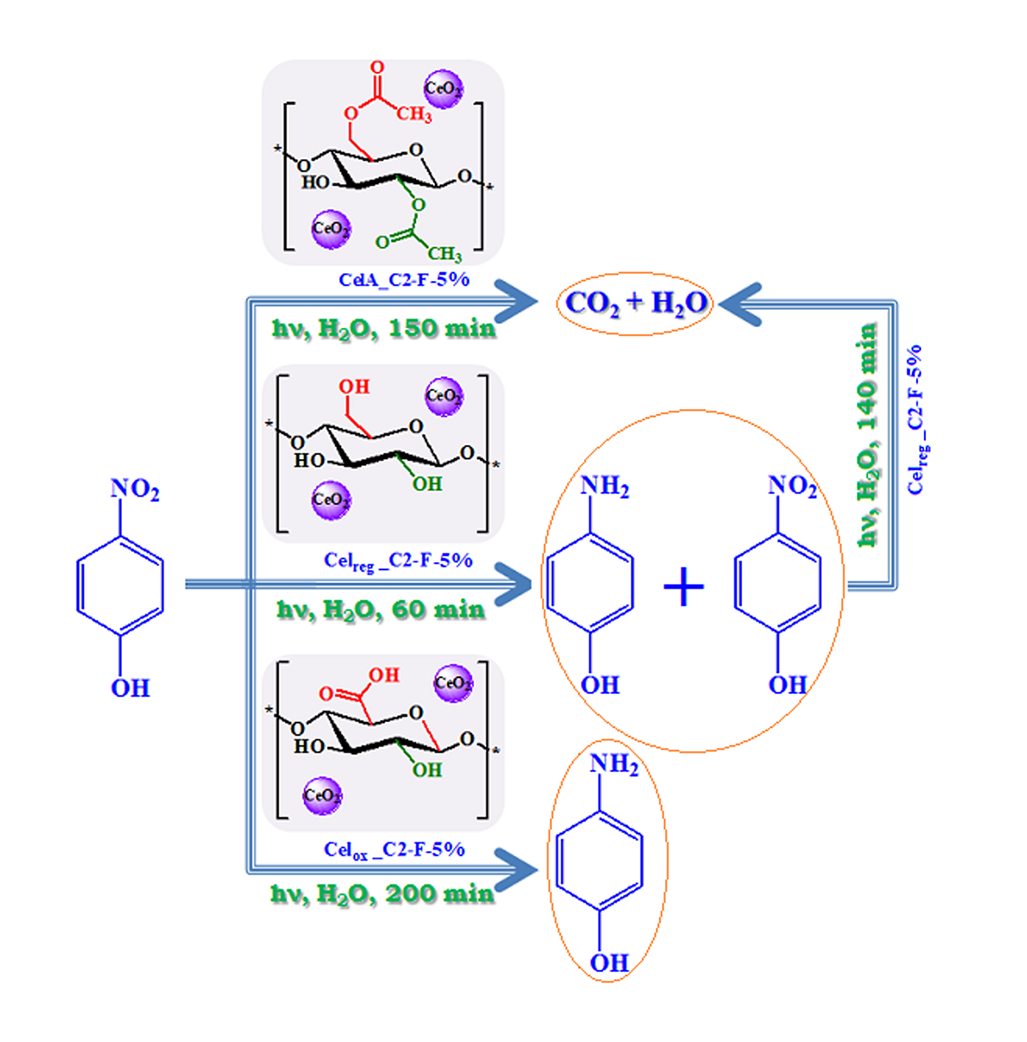
UV-Vis absorption spectrum of aqueous 4-nitrophenol solution in the presence of 5% C2-F hybrid films embedded in different cellulosic matrices: (a) cellulose acetate, (b) regenerated cellulose and (c) oxidized cellulose
Stage 3/2022 - Development of hybrid composites with catalytic activity shifted in the field of visible light starting from the previously designed photocatalysts with the best properties in which noble metal nanoparticles (Au, Ag, Pd) will be generated
Activity 3.1 - Preparation of cellulosic hybrid composites which includes nanoparticles of CeO2 and plasmonic metallic nanostructures (Au, Ag, Pd) with catalytic activity under visible light
Activity 3.2 - Evaluation of cellulosic composites catalytic activity incorporating CeO2 nanoparticles and noble metals in the photodegradation of pollutants under visible light
The third stage of the POLYCER project focused on improving the photocatalytic efficiency of cellulosic hybrid materials with CeO2 NPs in the visible range by generating nanoparticles of noble metals (Au, Ag, Pd) in the organic matrix.
The preparation of hybrid composites involves the use of photopolymerization process, and for some samples, the in situ photogeneration of Ag, Au or Pd metal nanoparticles. The resultant nanocomposites were analysed using scanning electron microscopy (SEM), X-ray diffraction (XRD), Fourier transform infrared spectroscopy (FT-IR), and UV-visible spectroscopy. The incorporation of CeO2 NPs into an organic matrix with the suitable functionalities, namely urethane and hydroxyl groups, favour the interfacial charge transfer reducing the Eg up to 2.85 eV. The presence of noble metal nanoparticles, such as Ag, Au and Pd introduction in nanocomposites, significantly lowered the Eg: 2.1 eV for CeAg samples, 1.7 eV for CeAu films and 1.5 eV for CePd films respectively. Complex CeO2 composites containing noble metal nanoparticles (Ag, Au, Pd) photogenerated in situ concurrent with the photocrosslinking process have better photocatalytic activity in visible light in brilliant green degradation, with the reaction taking only 60 min in the presence of F1-CeAg composite compared to 120 min in the presence of F1-Ce film. This opens up new avenues for the creation of flexible cellulose-based photocatalysts that are active in visible light.
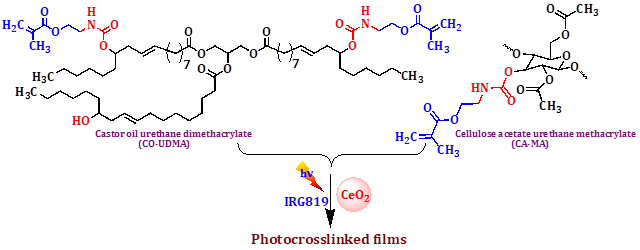
Schematic diagram for the preparation of crosslinked networks with CeO2 NPs by photopolymerization
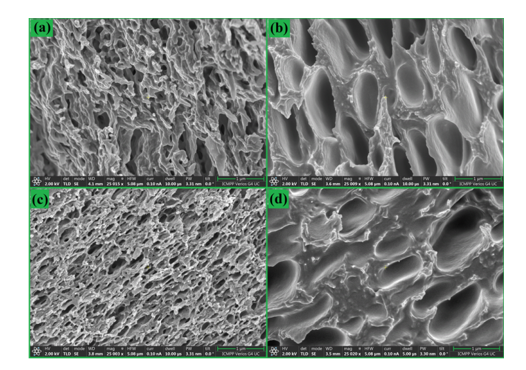
SEM images for F1-Ce (a), F2-Ce (b), F1-CePd (c) and F2-CePd (d) samples
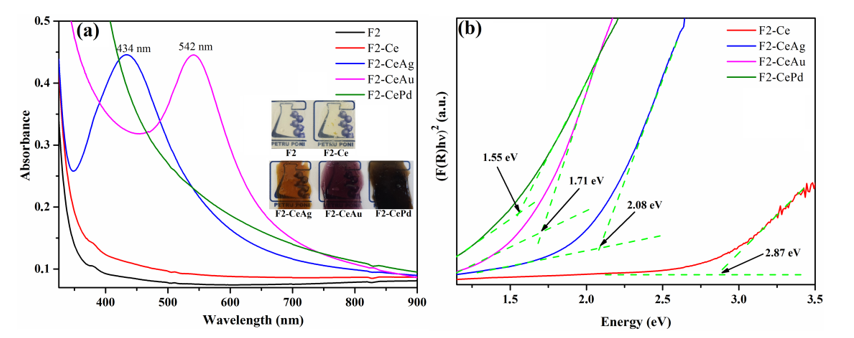
UV-vis absorption spectra (a) and the Kubelka–Munk plots of F2, F2-Ce, F2-CeAg, F2-CeAu and F2-CePd samples (b)

Modification of UV-vis absorption spectrum of brilliant green (BG) aqueous solution in the presence of F1-CeAg film (a); temporal evolution of BG photodegradation efficiencies (Ct/C0) in the presence of hybrid films from F1 series (b) and F2 series (c)
The impact of the results obtained within the POLYCER project is mainly reflected by the significant contribution to the scientific progress of knowledge in the nanomaterials field, mainly within those that include CeO2 nanoparticles. Also, through this project, new approaches have been developed in order to ecologically design hybrid composites with improved performances in photocatalysis applications, in particular, to be used in the water decontamination process or even in industrial organic reactions.
Expanding knowledge in the field of photocatalytic materials containing CeO2 nanoparticles is based on the most important project results:
- optimizing the specific reaction conditions for the synthesis of CeO2 nanoparticles in order to achieve a good control over the specific properties (bandgap energy, Eg) with implications on the catalytic efficiency and directing them towards the use in visible/solar light;
- optimizing, especially reducing, the Eg value by chemical functionalization of CeO2 NPs with silane derivatives or by integrating CeO2 NPs into an organic matrix with appropriate functional groups, which favors interfacial charge transfer;
- investigating the role of the cellulosic substrate in the photocatalysis process: managing easily the way of transforming 4-nitrophenol (mineralization vs. reduction to 4-aminophenol) represents a very important achievement within the project. The modification of the cellulosic substrate through regeneration and oxidation treatment, resulting in a material based on oxidized cellulose, offers an excellent catalyst alternative for 4-nitrophenol into 4-aminophenol transformation, without adding a reducing agent to the reaction mixture;
- the introduction of a ternary component in the preparation of hybrid materials, namely noble metal nanoparticles (especially those of Ag), leads to a significant decrease in the Eg values and to a high performance of the catalysts in visible light;
- hybrid composites proposed in this project represent promising photocatalysts under sunlight action for cyclic use in practical applications.
The most significant result of the POLYCER project is the design of a versatile photocatalyst under UV and visible light action (with lower efficiency), which can be applied both for the mineralization of 4-nitrophenol in water purification and for the industrial reaction of reducing the nitroderivative to 4-aminophenol, without adding a reducing agent to the reaction mixture. The proposed photocatalyst has a cellulose acetate substrate, and is suitable for the mineralization reaction.
The versatility of this material consists in the fact that by simply modifying the cellulosic substrate through regeneration and oxidation treatment, a photocatalyst with an oxidized cellulose substrate is resulted, which is a viable aspect for the reduction reaction of 4-nitrophenol to 4-aminophenol. These results led to the publication of the "Mineralization versus photoreduction of 4-nitrophenol under the influence of surface functionalized CeO2 nanoparticles, hosted by versatile cellulose supports” paper in the journal of Applied Surface Science (IF = 7,392), top 1 in the Materials science, coatings & films category.
Following this report and the previous stage reports, we consider that the research topic addressed within the POLYCER project aligns with the funding directions request and the purpose of the TE program within PNCDI III. The future research directions will aim to expand the studies in the field of photocatalysts based on CeO2 NPs, aiming at the same time to obtain financial resources by participating in various national and international competitions or creating partnerships with the economic environment.
The scientific results of the project are kept up-to-date on the POLYCER project website and can be accessed at https://icmpp.ro/projects/l2/about.php?id=17. Besides, the status of the papers under evaluation will also be permanently updated. Moreover, for additional scientific and technical details to this report, we recommend to consult the project website and the corresponding stage reports.
The project financial allowed to acquire new equipment which contributed greatly into the activities fulfillment within the POLYCER project. Thus, within the "Petru Poni" Institute of Macromolecular Chemistry, a Fluorescence Spectrometer RF-6000 was purchased, which successfully serves for the working group involved in this project.
The research results were valued by publishing scientific papers and participating in national and international conferences. All the indicators proposed in the funding application (4 ISI papers and presentations at national/international conferences) were met and even exceeded, within this project being reported 5 published ISI papers, 3 ISI papers sent for publication and 11 participations in national conferences/ international, of which 2 participations were invited conferences.
Thus, as indicators of the project we report:
- V. Melinte, A.L. Chibac-Scutaru, M.E. Culica, S. Coseri, Mineralization versus photoreduction of 4-nitrophenol under the influence of surface functionalized CeO2 nanoparticles, hosted by versatile cellulose supports, Applied Surface Science 565, 150494 (2021) IF = 7.392.
- A.L. Chibac-Scutaru, C. Cojocaru, G. Roman, P. Samoila, G. Sacarescu, M. Simionescu, L. Sacarescu, Synthesis of benzaldehyde-grafted polysilane: A highly stable and selective "turn-on" fluorescent sensor for cytosine, Journal of Molecular Liquids 326, 115300 (2021) IF = 6.633.
- L. Sacarescu, C. Cojocaru, G. Roman, G. Sacarescu, M. Simionescu, P. Samoila, A.L. Chibac-Scutaru, Nano-assembly and optical properties of difluoroboron dibenzoylmethane-polysilane, Polymer 232, 124188 (2021) IF = 4.432.
- A.L. Chibac-Scutaru, V. Podasca, A.I. Dascalu, V. Melinte, Exploring the influence of synthesis parameters on the optical properties for various CeO2 NPs, Nanomaterials 12, 1402 (2022) IF = 5.719.
- L. Sacarescu, M. Dascalu, A.L. Chibac-Scutaru, G. Roman, Synthesis, structural characterization, photophysical study and investigation as fluorescent sensor towards metal ions of 1,2,3-triazole–azaindene hybrids, Journal of Photochemistry & Photobiology, A: Chemistry 433, 114160 (2022) IF = 5.141.
- V. Melinte, S.I. Trifan, A.L. Chibac-Scutaru, V. Podasca, S. Coseri, Reusable catalysts based on CeO2/cellulose derivative with visible light photocatalytic activity tuned by noble metal nanoparticles inclusion, International Journal of Biological Macromolecules (2022) – under evaluation
- M.E. Culica, A.L. Chibac-Scutaru, V. Podasca, V. Melinte, Cellulose acetate- polyurethane blend containing CeO2-Co catalysts for pharmaceuticals removal from wastewater, Journal of Environmental Chemical Engineering (2022) – under evaluation
- L. Sacarescu, A.L. Chibac-Scutaru, G. Roman, G. Sacarescu, M. Simionescu, Advances in the detection of analytes using fluorescent pyrazolines as selective sensors, Environmental Chemistry Letters (2022) – under evaluation
- 2 participations in conferences with invited presentations:
- A.L. Chibac-Scutaru, V. Melinte, CeO2 nanoparticles embedded in different cellulosic substrates: photocatalytic materials for pollutant removal or organic reactions, The 10th Global Conference on Materials Science and Engineering - CMSE 2021, Online, August 1-4, 2021.
- A.L. Chibac-Scutaru, V. Melinte, Photocatalytic materials based on CeO2 nanoparticles and photocrosslinked cellulosic matrices. Insights into the pollutant removal catalysis mechanism, The 11th Global Conference on Materials Science and Engineering - CMSE 2022, Shenzhen, China / Online, August 8-11, 2022.
- 7 participations in conferences with oral presentations:
- M.E. Culica, A.L. Chibac-Scutaru, V. Melinte, S. Coseri, Novel support based on renewable resources doped with cerium oxide nanoparticles with technical applications, SICHEM 2020, Bucharest, Romania, September 17– 18, 2020.
- A.L. Chibac-Scutaru, V. Melinte, M. Culica, S. Coseri, Synthesis, organic functionalization and immobilization of CeO2 nanoparticles in cellulose matrix. Evaluation of their photocatalytic efficiency, SICHEM 2020, Bucharest, Romania, September 17–18, 2020.
- M.E. Culica, A.L. Chibac-Scutaru, V. Melinte, S. Coseri, Stabilization of cerium oxide nanoparticles by natural derived polymeric matrices, Sesiunea de Comunicari Stiintifice a Tinerilor Cercetatori, MacroYouth, Iasi, Romania, November 19, 2020.
- M.E. Culica, A.L. Chibac-Scutaru, V. Melinte, S. Coseri, Cellulose - derived matrices for functionalized CeO2 nanoparticles immobilization, and their photocatalytic behaviour, 2nd Bucharest Polymer Conference, Bucharest, Romania, June 9-11, 2021
- L. Stroea, A.L. Chibac-Scutaru, V. Melinte, UV-Shielding ability of aliphatic polyurethane – silane-functionalized TiO2 nanoparticle elastomeric coatings, 2nd Bucharest Polymer Conference, Bucharest, Romania, June 9-11, 2021.
- A.L. Chibac-Scutaru, V. Melinte, M.E. Culica, S. Coseri, Versatility of cellulosic matrix used for immobilization of synthesized CeO2 nanoparticles in tailoring the photocatalytic properties of hybrid composites, The 3rd International Workshop Advances on Photocatalysis AdvPhotoCat-EE2021, Online, June 28-29, 2021.
- L. Stroea, A.L. Chibac-Scutaru, V. Melinte, Surface functionalization of inorganic nanoparticles for covalent immobilization in polymer matrices, 13th International Conference on Physics of Advanced Materials, Sant Feliu de Guixols, Spain, September 24-30, 2021
- 2 participations in conferences with posters:
- V. Melinte, A.L. Chibac–Scutaru, V. Podasca, Comparative structural, morphological and optical characterization of CeO2/doped-CeO2 nanoparticles, 13th International Conference on Physics of Advanced Materials, Sant Feliu de Guixols, Spain, September 24-30, 2021
- V. Melinte, A.L. Chibac–Scutaru, V. Podasca, Synthesis and physicochemical characterization of cerium oxide nanoparticles, Polymer Networks Group - PNG 2022, Rome, Italy, June 12-16, 2022.
|








